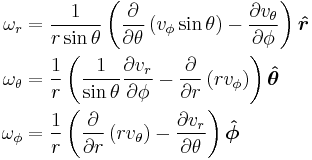Stokes stream function
In fluid dynamics, the Stokes stream function is used to describe the streamlines and flow velocity in a three-dimensional incompressible flow with axisymmetry. A surface with a constant value of the Stokes stream function encloses a streamtube, everywhere tangential to the flow velocity vectors. Further, the volume flux within this streamtube is constant, and all the streamlines of the flow are located on this surface. The velocity field associated with the Stokes stream function is solenoidal—it has zero divergence. This stream function is named in honor of George Gabriel Stokes.
Contents |
Cylindrical coordinates
Consider a cylindrical coordinate system ( ρ , φ , z ), with the z–axis the line around which the incompressible flow is axisymmetrical, φ the azimuthal angle and ρ the distance to the z–axis. Then the flow velocity components uρ and uz can be expressed in terms of the Stokes stream function  by:[1]
by:[1]
The azimuthal velocity component uφ does not depend on the stream function. Due to the axisymmetry, all three velocity components ( uρ , uφ , uz ) only depend on ρ and z and not on the azimuth φ.
The volume flux, through the surface bounded by a constant value ψ of the Stokes stream function, is equal to 2π ψ.
Spherical coordinates
In spherical coordinates ( r , θ , φ ), r is the radial distance from the origin, θ is the zenith angle and φ is the azimuthal angle. In axisymmetric flow, with θ = 0 the rotational symmetry axis, the quantities describing the flow are again independent of the azimuth φ. The flow velocity components ur and uθ are related to the Stokes stream function  through:[2]
through:[2]
Again, the azimuthal velocity component uφ is not a function of the Stokes stream function ψ. The volume flux through a stream tube, bounded by a surface of constant ψ, equals 2π ψ, as before.
Vorticity
The vorticity is defined as:
 , where
, where  .
.
-
Derivation of vorticity  using a Stokes stream function
using a Stokes stream functionConsider the vorticity as defined by From the definition of the curl in spherical coordinates:
First we notice that the
 and
and  components are equal to 0. Secondly we substitute
components are equal to 0. Secondly we substitute  and
and  into
into  then we get:
then we get:If we do the algebra:
If we do the calculation we find that the vorticity vector is equal to:
If we define the new operator  then we have
then we have
Comparison with cylindrical
The cylindrical and spherical coordinate systems are related through
 and
and 
Zero divergence
In cylindrical coordinates, the divergence of the velocity field u becomes:[3]
as expected for an incompressible flow.
And in spherical coordinates:[4]
References
- Batchelor, G.K. (1967). An Introduction to Fluid Dynamics. Cambridge University Press. ISBN 0521663962.
- Lamb, H. (1994). Hydrodynamics (6th ed.). Cambridge University Press. ISBN 9780521458689. Originally published in 1879, the 6th extended edition appeared first in 1932.
- Stokes, G.G. (1842). "On the steady motion of incompressible fluids". Transactions of the Cambridge Philosophical Society 7: 439–453.
Reprinted in: Stokes, G.G. (1880). Mathematical and Physical Papers, Volume I. Cambridge University Press. pp. 1–16. http://www.archive.org/details/mathphyspapers01stokrich.









